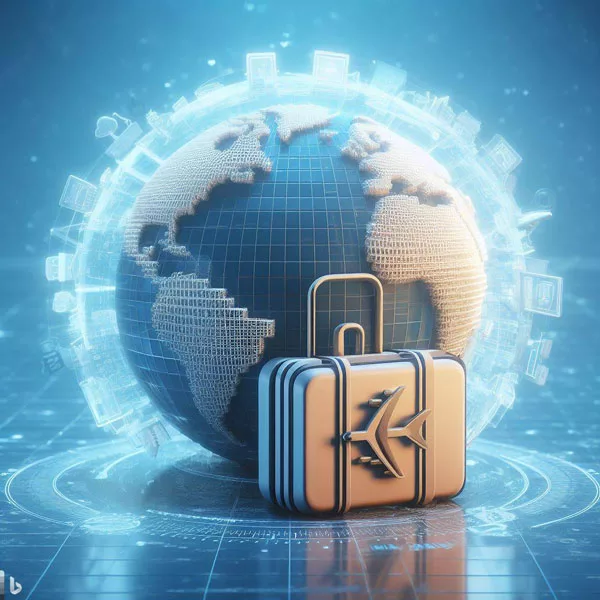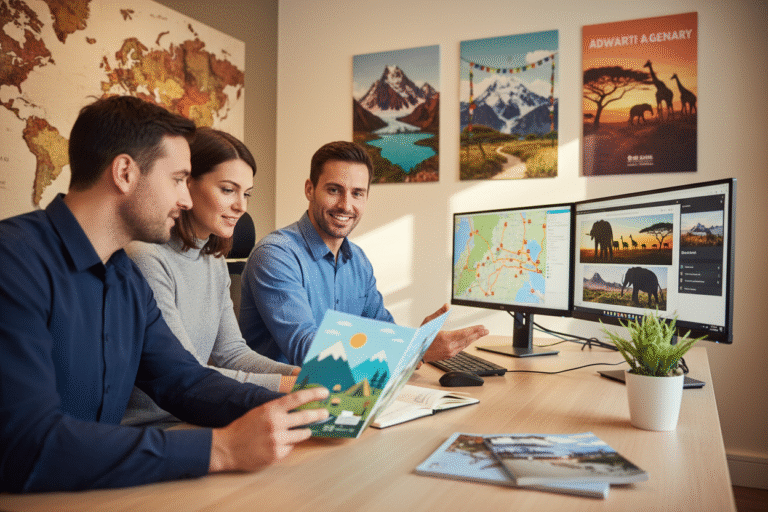Tips for Traveling Abroad for the First Time: Your First International Adventure
Quick, practical tips for traveling abroad for the first time so you feel prepared, calm, and genuinely excited for your first big trip.
So you finally did it: you booked the ticket, found your passport in that “super safe” drawer you immediately forgot about, and now your first international trip is actually happening. If you’re anything like I was before my first long-haul flight, your emotions are somewhere between I can’t believe I’m doing this and what if I accidentally move there because I can’t figure out how to get home?
That mix of excitement and low-key panic? Totally normal. In fact, when people ask me for tips for traveling abroad for the first time, I always start with this: you’re not supposed to feel ready. You’re supposed to feel curious and slightly unhinged. That’s how you know you’re about to have an adventure instead of just another week that looks like all your other weeks.
I still remember my first time going abroad. I packed the wrong adapter, nearly missed a connection because I misread a 24-hour clock, and had my card declined at a café in Amsterdam while holding a croissant like it was evidence in a crime scene. The barista was patient; my anxiety was not. But I learned, I adjusted, and by the end of the trip I felt like a slightly more competent version of myself.
This guide is everything I wish someone had told me back then—practical, honest tips for traveling abroad for the first time, with a few stories and side comments so you don’t fall asleep halfway through. We’ll talk documents, money, safety, culture shock, food, and all the weird little details nobody remembers to mention until it’s too late.
Getting the Boring-but-Crucial Stuff Sorted
Before we get to the fun parts like food and wandering cute side streets, we have to talk logistics. I know—about as thrilling as reading the terms and conditions on a software update. But these are the tips for traveling abroad for the first time that can literally make or break your trip, so it’s worth a cup of coffee and twenty minutes of adulting.
Check Your Passport and Visa (Before You Start Packing)
Here’s a very unsexy truth: the first thing you should check isn’t flights, hotels, or which outfits look best in photos. It’s your passport.
Most countries require your passport to be valid for at least six months beyond your return date. Not from your departure date—your return date. I’ve watched people get turned away at check-in because they missed this. One guy in line ahead of me at the airport found out his passport expired in four months. He had his suitcase, his neck pillow, his travel hoodie… and zero chance of boarding.
Flip through your passport and make sure:
- The expiration date is at least six months after you plan to come home.
- You’ve got enough blank pages for stamps (some countries want two side-by-side).

Next up: visas. Some destinations let you stroll in visa-free. Others want you to apply online in advance. A few still require in-person visits to a consulate, which feels like doing a side quest before the main game.
Check:
- Your own government’s travel site (like travel.state.gov if you’re in the US).
- The official embassy/consulate site of the country you’re visiting.
I once assumed a “short layover” meant I wouldn’t need anything special. Turns out, the country counted my time in the airport as an entry. No visa, no entry. I got an unexpected lesson in “airport limbo,” which is exactly as fun as it sounds.
Why Travel Insurance Is Not Optional (Anymore)
I used to roll my eyes at travel insurance. It felt like one more upsell in a world full of subscription boxes and extended warranties I’ll never use.
Then a friend crashed a scooter in Bali.
She ended up with a broken ankle, a hospital stay, and a bill that looked like a phone number. No insurance. She’s fine now, but her credit score still isn’t speaking to her.
According to a 2019 study in the Journal of Travel Medicine, about 8% of international travelers experience a health issue serious enough to need medical attention abroad. Eight percent doesn’t sound huge until you remember that on a packed 300-seat plane, that’s 24 people.
Travel insurance can cover medical care, emergency evacuations, lost luggage, trip cancellations, and more. The key is to
- Read what’s actually covered (and not covered).
- Make sure it applies to every country on your route.
I always screenshot my policy details and keep them in a folder on my phone, just in case I need to reference them from a waiting room somewhere.
Tell Your Bank You’re Going on an Adventure
Imagine this: you’re in a cozy café in a new city, you order something you can’t pronounce, you tap your card like the confident international traveler you’ve become… and it’s declined.
Not because you’re broke. Because your bank thinks you’re being robbed.
Most banks and card companies have automatic fraud detection. If they see charges suddenly popping up in Tokyo, Lisbon, or Nairobi, they may freeze your card until you confirm it’s actually you.
Before you leave:
- Log in to your banking app or call the number on the back of your card.
- Add a travel notice with your destination countries and dates.
- Ask about foreign transaction fees (some charge around 3% per purchase).
I eventually switched to a card with no foreign transaction fees, and it made a bigger difference than I expected. That 3% doesn’t sound like a lot—until you do a rough total and realize you basically tipped your bank the price of a decent hotel night.
Make Copies of the Things You Really Don’t Want to Lose
One of my most underrated tips for traveling abroad for the first time: make friends with your scanner or camera app.
Before your trip, make digital copies of:
- Your passport photo page
- Any visa documents
- Travel insurance policy
- Flight and accommodation confirmations
- Your credit card fronts (with the emergency number on the back noted separately)
Store them in encrypted notes, a secure cloud folder, or email them to yourself with a subject line you can easily search. I also leave a copy with someone I trust back home.
This system has saved me more than once. Once, my wallet went missing in Barcelona. I had my passport locked in the hotel safe and my document copies on my phone. Was it stressful? Yes. Was it a full-scale identity crisis? No. Progress.
Packing Without Bringing Your Entire Closet
Let’s talk about the suitcase situation.
Almost everyone overpacks the first time. I absolutely did. I brought shoes that never left the suitcase, “just in case” outfits for scenarios that never happened, and a stack of books as if I were going on a silent reading retreat instead of a trip.
The “Half-Your-Pile” Rule
Here’s a simple rule I now swear by and always recommend as one of the best tips for traveling abroad for the first time: lay out everything you think you’ll need… then put half of it back.
You think you’ll want options. Future-you will want to not drag a 23-kg suitcase up three flights of stairs at a guesthouse with no elevator.
Focus on:
- Neutral basics you can mix and match
- Layers instead of bulky single-purpose items
- Comfortable walking shoes you’ve actually worn before
I once brought a brand-new pair of boots to break in on a trip. By day two, I was limping through a museum like an extra in a historical drama.
Carry-On: Your Safety Net
If your checked bag decides to go on its own little adventure (it happens), your carry-on is what stands between you and three days of wearing airplane clothes in public.
I always keep this in my carry-on:
- A full change of clothes (including underwear and socks)
- Medications and a small basic first-aid kit
- Electronics and chargers
- Travel-size toiletries that won’t traumatize airport security
SITA’s 2022 Baggage IT Insights report found that airlines mishandled 7.6 bags per thousand passengers. That sounds small—until it’s your bag doing laps somewhere over the Atlantic.
The Adapter Situation (Learn From My Mistake)
Different regions use different plug shapes and voltages, because apparently at some point the world collectively decided, “Let’s make this as confusing as possible for future travelers.”
Do a quick search for “power outlets in yourdestination” and:
- Buy a solid universal adapter that works in multiple regions
- Check if your electronics support dual voltage (100–240V)
Most phone and laptop chargers do. Hair tools often don’t. I’ve seen more than one curling iron go out in a blaze of tragic glory.
I now travel with one chunky, not-at-all-cute adapter that has USB ports and works almost everywhere. It’s not Instagrammable, but my phone is always charged and my laptop hasn’t exploded, so I’m calling it a win.
Money, Cards, and Not Getting Stuck at an ATM
Money worries are a big part of first-time travel nerves. Nobody wants their great adventure to turn into “that time I couldn’t pay for dinner and had to wash dishes for three hours.”
Cash vs. Card: Find Your Balance
Most places now accept cards, especially in cities, but cash is still very much alive—particularly at local markets, small shops, and older taxis.
For tips for traveling abroad for the first time that actually work in real life, I usually suggest:
- Use a card (preferably with no foreign transaction fees) for hotels, big purchases, and many restaurants.
- Withdraw some local currency from ATMs for small daily expenses.
Airport exchange counters are convenient but often have poor rates and high fees. ATMs linked to major banks usually offer better exchange rates. When the ATM asks if you want to be charged in your home currency or the local one, choose local. That usually avoids an extra, hidden conversion fee.
How Much Cash Should You Carry?
Personally, I like to land with enough cash for at least a couple of days—think transit from the airport, a few meals, and a buffer.
On many trips, that means the equivalent of about $100–$200 in local currency. The exact amount depends on how expensive the destination is, but the principle is the same: enough to function, not so much that losing it would ruin your month.
I split my cash into a few different spots: some in my wallet, some in my bag, and a little emergency backup somewhere harder to reach. Have I ever felt slightly ridiculous hiding money in random compartments? Absolutely. Have I also been extremely glad I did it when an ATM briefly ate my card in Vietnam? Also yes.
Tipping Without Awkwardness
Tipping customs are one of those things you don’t think about until the bill arrives and you suddenly feel like you’re defusing a bomb.
In the US, 15–20% is standard at restaurants. In Japan, tipping can actually be considered rude. In some European countries, service is included; in others, rounding up or leaving 5–10% is appreciated.
Before you go, it’s worth spending ten minutes checking:
- Typical tipping expectations in restaurants
- Whether tipping is normal for taxis, guides, or hotel staff
I like using local blogs or recent travel forums for this—they’re often more up to date than old guidebooks.
Phone, Internet, and Staying Sane on Maps
You don’t realize how much you rely on your phone until you’re standing on a street corner in a foreign city, realizing you have no data, no map, and no idea which direction is north.
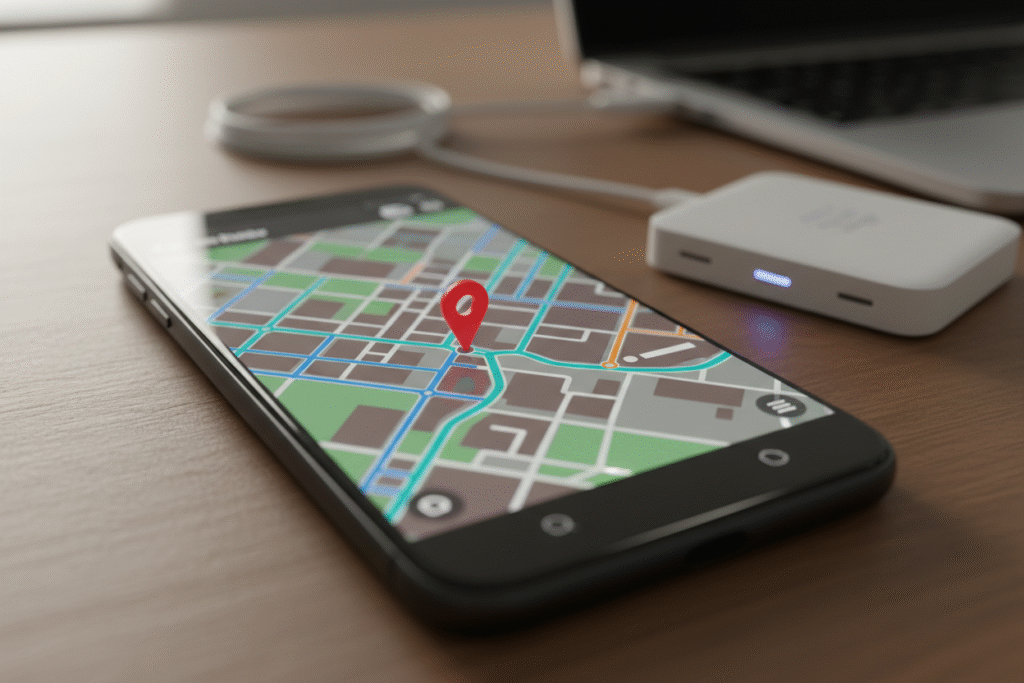
International Plans vs. Local SIM Cards
When it comes to connectivity, you’ve got three main options:
- Turn on international roaming and accept the bill later (my least favorite strategy).
- Add an international plan or day-pass from your current provider.
- Get a local SIM or eSIM at your destination.
If you’re only going away for a week or two and your carrier offers a reasonable roaming plan, that can be the simplest. If you’re staying longer or hopping between countries, a local SIM or regional eSIM can save serious money.
Just make sure your phone is unlocked before you leave, or that dreamy local data plan will remain theoretical.
The Underrated Magic of Offline Maps
One of my favorite small-but-mighty tips for traveling abroad for the first time: download offline maps.
Apps like Google Maps let you save regions to your phone so you can use them without data. GPS still works, so you can:
- See where you are
- Search for addresses and landmarks within the saved area
- Get walking directions
I now download offline maps for every city on my itinerary. It’s the difference between “Oh, we missed the turn, no big deal” and “We are lost, it’s dark, and this suddenly feels like the beginning of a documentary.”
Safety Without Spiraling Into Paranoia
Let’s be honest—safety is one of the biggest things people worry about with international travel. And sure, there are real risks. But there’s also a lot of fear that comes from not knowing what to expect.
Common Sense Goes a Long Way
Most safety tips for traveling abroad for the first time are surprisingly similar to “being a functioning adult at home,” just with a little more awareness.
A few basics I try to stick to:
- Avoid flashing large amounts of cash or valuables.
- Be extra aware of your stuff in crowds and on public transit.
- If a situation or person feels off, trust that feeling.
Before I visit a new country, I usually search “common tourist scams in city.” Is it fun reading? Absolutely not. Does it help me recognize when someone is trying to tie a “free bracelet” onto my wrist and then demand money? Every time.
Keeping Your Valuables Secure (Without a Full Tactical Vest)
You do not need to travel in a money belt strapped to your torso at all times (unless that’s your look—no judgment). But it is worth having a small system.
What’s worked well for me:
- Passport, backup cards, and emergency cash locked in the hotel safe or a hidden pouch.
- Daily wallet with just one card and the cash I plan to use that day.
Anti-theft bags with hidden zippers are nice in crowded cities, but they’re not mandatory. The goal isn’t to eliminate risk (that’s impossible); it’s to make yourself just a little more inconvenient to steal from than the next person.
Registering Your Trip (The Grown-Up Step That Takes 5 Minutes)
Many governments have free programs where you can register your international trip. For US travelers, that’s the Smart Traveler Enrollment Program (STEP).
Once registered:
- Your embassy can contact you in case of emergencies (natural disasters, political unrest, etc.).
- You can get important updates about safety or travel conditions.
I didn’t bother with this for my first few trips. Then a friend got caught in sudden protests overseas, and the embassy’s alerts helped her make smart decisions quickly. Now I take the five minutes and register. Future-me appreciates it.
Navigating Culture Without Being “That” Tourist
One of the best parts of traveling abroad is getting to experience how other people live. It’s also where a lot of quiet anxiety lives: What if I mess up? What if I accidentally offend someone? What if I eat something wrong and cause an international incident?
Learn a Few Local Basics
You don’t need to become fluent before you arrive. But learning a few words in the local language is one of the easiest and most underrated tips for traveling abroad for the first time.
I always try to learn how to say:
- Hello
- Please
- Thank you
- Excuse me / sorry
- Do you speak English?
My pronunciation is usually questionable, but people almost always appreciate the effort. I’ve had gruff shop owners soften instantly the moment I attempted even a clumsy greeting in their language.
Research a Little Etiquette in Advance
Different cultures have different expectations around tipping, greetings, personal space, shoes in the house, noise levels, and pretty much everything else.
I like to spend an evening before a trip reading:
- Whether there are areas where modest dress is expected
- How people typically greet each other
- Any “big no-nos” (like pointing with your feet in some countries)
None of this is about being perfect; it’s about showing you care enough to try.
Culture Shock Is Normal (And Temporary)
At some point, you may hit a wall where everything just feels like… too much. Too loud, too different, too confusing.
Researchers have actually studied this. In the International Journal of Intercultural Relations, there’s a well-known “U-curve” model of cultural adjustment: initial excitement, followed by frustration, then gradual adaptation.
Knowing that dip is normal makes it easier to ride out. When I hit that point, my routine is simple:
- Eat something vaguely familiar.
- Call or text someone who gets me.
- Remind myself that being uncomfortable is part of why I came.
Food, Jet Lag, and All the Messy Human Stuff
Behind all the glamorous photos of airplane wings and city skylines, there’s the real side of travel: messed-up sleep, questionable street food, and that moment when you realize you have no idea how to use the local transit system.
Jet Lag: Not a Moral Failing, Just Biology
If you’re crossing time zones, jet lag is almost guaranteed. It’s not you being weak; it’s your internal clock being confused.
A study in the Journal of Clinical Sleep Medicine notes that timed light exposure is one of the most effective ways to reduce jet lag. Translation: sunlight is your friend.
What helps me:
- Start shifting my sleep schedule a day or two before flying.
- Drink more water than I think I need on the flight.
- Walk outside in daylight once I land, even if I’m tired.
Is it fun? Not particularly. Does it make day two and three much better? Absolutely.
Trying the Food Without Destroying Your Stomach
Food is a huge part of why many of us travel. I’ve had some of my favorite life memories at tiny restaurants I found by accident.
A few gentle guidelines I follow:
- I look for busy spots full of locals—high turnover usually means fresher food.
- For the first couple of days, I go a bit easy on raw foods and street snacks in very hot climates.
- I always pack a small “stomach emergency” kit: rehydration salts, anti-diarrheal tablets, and something for mild food poisoning.
I’m not saying you should travel in fear of every bite. I’m saying that having a backup plan in your bag makes it easier to say yes to that interesting dish you can’t pronounce.
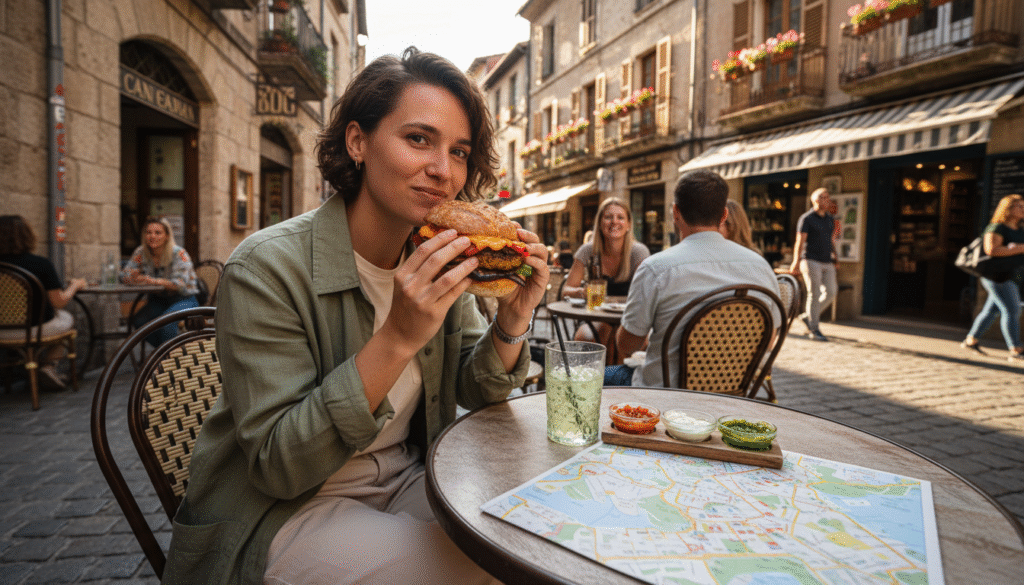
Planning Just Enough (But Not Too Much)
When people ask for tips for traveling abroad for the first time, this is usually where we land: “How much should I plan?”
Some folks love spreadsheets with hour-by-hour breakdowns. Others want to just show up and “see what happens.” Most of us do best somewhere in between.
What I’ve found works well:
- Book your first few nights of accommodation in advance.
- Make a short list of “non-negotiables” you really want to see or do.
- Leave some blocks of completely unscheduled time.
This way you’re not wasting half your trip researching basic logistics, but you’re also not turning it into a military operation where joy must be experienced between 14:00 and 14:30.
Some of my favorite memories came from those unplanned windows: following music down a side street to a local festival, lingering at a café because the conversation was too good to rush, joining a small walking tour I found on a flyer.
Coming Home a Little Different (In a Good Way)
Here’s something people don’t talk about enough when they share tips for traveling abroad for the first time: coming home can feel strange, too.
Your own grocery store might feel huge. People might seem rushed or oddly loud. You’ll try to tell stories and realize you can’t quite capture what it felt like to sit by that river or wander that market.
That’s okay. In a weird way, it’s a sign that the trip did what it was supposed to do—it stretched you a little.
I like to:
- Look through my photos slowly instead of just dumping them on social media.
- Jot down a few “I don’t want to forget this” moments in a journal or notes app.
- Notice what I appreciate more (or less) about home now.
Travel doesn’t have to turn you into a whole new person. But it almost always hands you a small, quiet shift in perspective. Sometimes that shift is what lingers the longest.
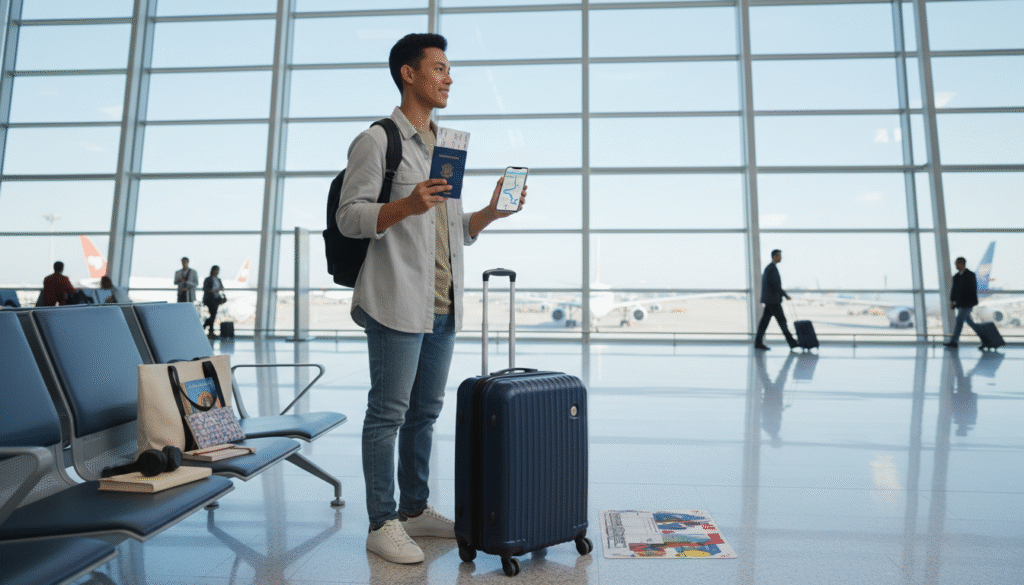
Final Thoughts: You’re More Ready Than You Feel
If you’ve made it this far, here’s what I want you to remember most about these tips for traveling abroad for the first time: you don’t need to do it perfectly for it to be worth it.
You will forget something. You will misunderstand someone. You’ll probably have at least one moment where you wonder what on earth you were thinking when you booked this.
And still—somewhere between the jet lag and the new streets and the unfamiliar menus—you’ll also have a moment where it hits you: I did this. I got myself here. I can figure things out.
That’s the real gift of traveling abroad for the first time. Not just the photos or stories (though those are great), but the quiet confidence that comes from proving to yourself that you can handle more than you thought.
So check your passport. Tell your bank. Pack a little less than you think you need. Save this guide, skim these tips again closer to your departure date, and then go live your own version of all this.
Your first international adventure doesn’t have to be flawless to be unforgettable. It just has to be yours.
And if you find yourself in a café somewhere, card temporarily declined, holding a pastry and wondering what to do next—take a breath. Smile. You’re officially a traveler now. You’ll figure it out.


